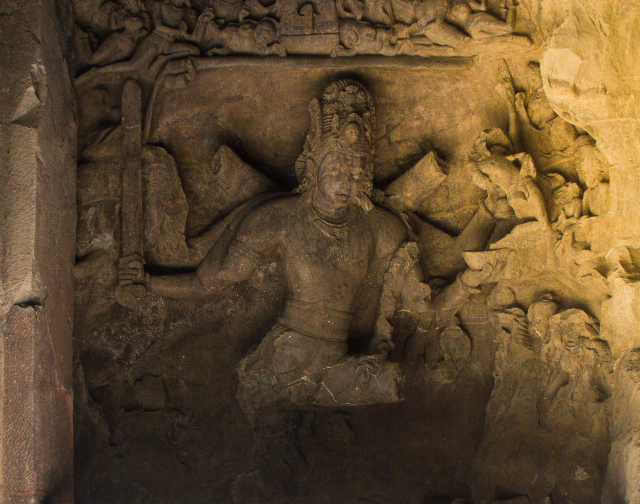Elephanta
Island is about an hour from Mumbai
chugging slowly on an ancient tub. It was weekend so the boat was crowded
with locals off for a spree to see the famous caves.
We
embarked from Apollo Bunder, right in
front of the gateway to India, the scene as the boat departed was a tourist
postcard, gateway framing the Taj Mahal hotel in the background and the awful tower
which is the extension of the hotel. Tickets were really cheap 120 R return. As we
advanced into the sea we could see the skyline of the Mumbai which we had not,
and probably would never discover, super tall blocks, all shiny new glinting in
the sunlight.
On
arrival we walked along a long pier towards the island, there was a small gauge toy train which was immediately
packed inside and out. The island was incredibly green and lush palms, tamarind
and mango trees, steep hills arising
abruptly.
I wondered what the Portuguese sailors thought they would find when
they first came ashore in 1534; we don’t know what they thought of the
magnificent cave temples but we know what they did, an enormous amount of damage,
shooting mostly all the lower portions of the rock sculptures and stealing the huge basalt stone elephant
at the entrance to the caves, they
managed to drag it down to the sea with chains which promptly broke sending the
massive sculpture to the bottom of the sea, it was rescued during the British colonial years and taken to a
museum in Mumbai. It was the Portuguese who named the island Elephanta but it
is actually called Gharapuri, city of the caves.
At the end of the pier there is a steep climb on a paved path to the entrance of the cave area. The way is lined with stalls under the trees, also our first sight of monkeys being very naughty, grabbing any food in evidence and other monkey business. We were intrigued to see a line of heavy wooden chairs with sturdy poles, evidently for carrying people up the hill, must be a four man task, regretfully we didn’t see this sight in action as we trudged up.

The caves' origin is dated approximately during the period 450 to 750 AD, there are no inscriptions so the dates are based on the fact that this period marks the decline of Buddhism in India and the revival of the Brahmanical traditions.
There are two groups of caves—the first is a large group of five Hindu caves, the second, a smaller group of two Buddhist caves.
The Hindu caves are from the Shaiva Hindu sect, stone sculptures were hewn from the basalt rock and dedicated to Lord Shiva, as usual with many lingum , symbols of divine generative energy, usually a phallic object as a symbol of Shiva. Apparently the caves were originally painted but now only traces remain.
The caves are certainly impressive and must have had a wonderful sense of tranquillity when they were used as temples, just bird song, sound of the sea and beautiful Vedic mantras. It is difficult to grasp this nowadays, especially as the once fabulous sculptures are so tragically damaged, there is still beauty there but very sad and poignant, the remaining visages stare serenely into the unknown future.
https://en.wikipedia.org/wiki/Elephanta_Caves
At the end of the pier there is a steep climb on a paved path to the entrance of the cave area. The way is lined with stalls under the trees, also our first sight of monkeys being very naughty, grabbing any food in evidence and other monkey business. We were intrigued to see a line of heavy wooden chairs with sturdy poles, evidently for carrying people up the hill, must be a four man task, regretfully we didn’t see this sight in action as we trudged up.

The caves' origin is dated approximately during the period 450 to 750 AD, there are no inscriptions so the dates are based on the fact that this period marks the decline of Buddhism in India and the revival of the Brahmanical traditions.
There are two groups of caves—the first is a large group of five Hindu caves, the second, a smaller group of two Buddhist caves.
The Hindu caves are from the Shaiva Hindu sect, stone sculptures were hewn from the basalt rock and dedicated to Lord Shiva, as usual with many lingum , symbols of divine generative energy, usually a phallic object as a symbol of Shiva. Apparently the caves were originally painted but now only traces remain.
The caves are certainly impressive and must have had a wonderful sense of tranquillity when they were used as temples, just bird song, sound of the sea and beautiful Vedic mantras. It is difficult to grasp this nowadays, especially as the once fabulous sculptures are so tragically damaged, there is still beauty there but very sad and poignant, the remaining visages stare serenely into the unknown future.
https://en.wikipedia.org/wiki/Elephanta_Caves


























No comments:
Post a Comment
Follow the latest news from Finca al-manzil- What to do and see in Extremadura and Beyond.............